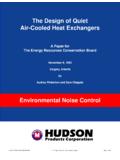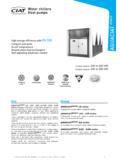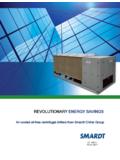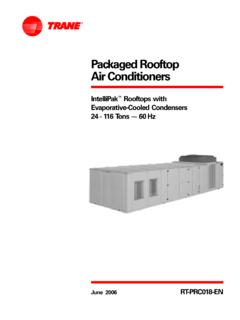Transcription of Edition No. 14 December 2002 ENGINEERING
1 Why Change the ChilledWater Temperature Range?ENGINEERINGThis issue of EngineeringSystem Solutions is onchilled and condenserwater temperature ranges. There is afair amount of informationcirculated these days on the best temperature ranges to use. Some ofthe information is good, some not, asit was true in the refrigerant wars of the 1990s. The topic iscomplicated; changing the chilledwater temperature will affect everycomponent in the cooling article attempts to show therelationships between thecomponents that make up the airconditioning system so that thereader can appreciate the is no one solution, no perfectoperating condition that will yieldthe best result for any and allbuildings.
2 The only absolute answer is that, unless it is backed upwith an energy analysis specific toyour application, care should more information on airconditioning system design, contactyour local McQuay representative orvisit CrowtherDirector of ApplicationsMcQuay North AmericaSYSTEM SOLUTIONSE dition No. 14 December 2002 Continued on next answer this question, let s review the primary goal of HVAC design. Thegoal is to provide the customer with a safe, comfortable environment at anacceptable life cycle cost. Focusing on life cycle cost brings up the necessarybalance between capital cost and operating cost. It is here that changing thechilled water temperature range becomes an issue.
3 To consider the capital cost,let s look to the following formula:Load (tons) = Flow (US gpm) x Temperature range ( F)/24orFlow (US gpm) = Load (tons) x 24/ Temperature Range ( F)As the chilled water temperature range is increased, the flow rate is decreasedfor the same capacity. Smaller flow means smaller pipes, pumps, insulation(area not R value), etc. This equates to capital savings. Notice that the chilledwater supply temperature is notpart of the equation. It has nothing to do withthese savings!To evaluate the operating cost, let s consider the following formula:Pump power (hp) = [Flow (US gpm) x Head (ft)] / [3960 x Pump efficiency]As the chilled water flow is decreased, the pump work is also decreased,assuming constant head.
4 This equates to operating savings. Notice again thatchilled water supply temperature has nothingto do with the pump head will remain approximately constant because the pipe sizes willbe decreased. ASHRAE recommends that piping design be based on a 4-footpressure drop per 100 feet of this requirement will letthe designer downsize piping as theflow the Entire SystemThe two considerations discussedabove are two very strong argumentsfor increasing the chilled watertemperature range. Theseconsiderations, however, are onlyfocused on the pumps and must consider the entireHVAC system and changing thechilled water temperature range willaffect the entire system!For comments or suggestions, please call or write:Chris Sackrison, EditorMcQuay International13600 Industrial Park BoulevardMinneapolis, MN 55441 Phone: (763) 553-5419E-mail: more information on McQuay products and services, or to speak with your local representative, call (800) 432-1342, or visit our web page at 2002 McQuay Internationalcontinued from previous pageperformance so it can be expected that the chillerpressure drops will not decrease with increased temper-ature ranges.
5 In addition, the passes will increase (twopass to three pass) as the range types, differentiated by compressor or manu-facturer, were not considered. While it is true that allchillers will behave generally the same, the specificproperties of a chiller will change the plant types will also affect the outcome. As thechilled water temperature range is increased, serieschillers will outperform either a single large chiller orparallel chillers. Series counterflow chillers willoutperform series chillers; however, the savings may belost when considering the condenser pump head is a key parameter. Increasing the pumphead will make the pump work more dominant andchange the mperature ranges are a complicated issue.
6 There is nosingle best solution that can be used for every case. Eachproject will have its own optimum operating further complicate matters, different chillers (eithertypes or manufacturers) will have their own optimumoperating conditions. Said another way; the bestMcQuay solution may not necessarily be the bestsolution for other chiller vendors and vice-versa. All chillers are negatively affected by increased compressorlift. Some chiller types (screw chillers, for instance) areless affected. Casually increasing the compressor lift forany chiller type or manufacturer will increase theoperating cost. Changing the temperature ranges andsupply temperatures requires careful analysis.
7 Thefollowing are some points to consider: The traditional ARI operating conditions workvery well for many buildings. Unnecessary reduction of the chilled water supplytemperature should be avoided because it increaseschiller work. When using standard products such as fan coilsand unit ventilators, maintain the chilled watertemperature range between 10 and 12 F wherethey are designed to operate. Increasing the chilled water temperature range is agood way to reduce the capital and pumpoperating cost, particularly if the pump head islarge or the piping runs 1 Chiller Heat Exchangers at ARI ConditionsMcQuay Air- cooled ChillersHigh Efficiency And Low Noise At An Affordable PriceMcQuay air- cooled scroll compressor chillers are thecomplete, factory-assembled solution for your HVAC requirements.
8 Our 10 to 130-ton chillers are loaded withvalue-added features at an affordable price. Efficient Meets or exceeds ASHRAE Standard (October 2001). Up to EER at full load, and upto EER at part load (IPLV). Quiet All dBA ratings are tested in accordance withARI Standard 370. Less acoustical treatment lowersyour project s cost. Reliable Tandem or trio scroll compressor sets percircuit have fewer moving parts. Two circuits at 26tons provide backup chilled water. Several options areavailable to enhance performance and reliability. Controls Flexibility Protocol Selectability allowsMicroTech II DDC controls to easily integrate intoyour building automation system of choice. And it ssimple to achieve interoperability using open, standardprotocols such as LonTalk or BACnet.
9 Flexible Options to Meet Your NeedsMcQuay offers you the flexibility to choose from manysizes and options to customize your air- cooled scrollcompressor chiller. Low ambient operation down to 0 F. Non-fused disconnect switches allow secure and easyservice. Phase voltage monitor senses and avoids undesirableelectrical conditions. Ice storage capability saves energy. Double evaporator insulation for ice storage operation. Condenser coil options provide longer equipment life(copper fins, Electrofin and Blackfin coating). Hot gas bypass for low load operation. Acoustical blanket wraps compressor for reducedsound (10 to 39 tons)AGZ-B (26 to 130 tons)continued on back pagecontinued from previous pageStarting with the ChillerThe purpose of a chiller is to collect heat from the chilledwater loop and reject it in the condenser water loop.
10 Thisprocess takes work, so a compressor is required. Figure 1shows the chiller s two heat exchangers. The bottom partof the figure shows the evaporator process. Here the heatleaves the chilled water in a sensible cooling process thatlowers the chilled water temperature. The heat enters therefrigerant, which boils (changes from a liquid to gas) at aconstant pressure and temperature. The refrigerant mustbe colder than the water (heat flows downhill) and thedifference is referred to as the top portion of Figure 1 shows the condenser the condenser water is warmed by the refrigerant condenses from a gas to a liquid at aconstant pressure and temperature. In this case, therefrigerant must be warmer than the condenser water.





